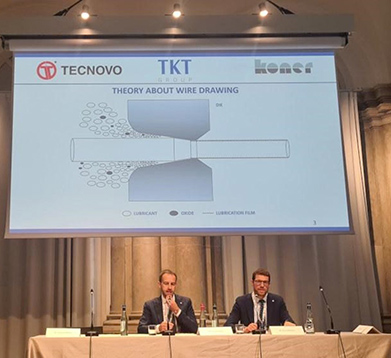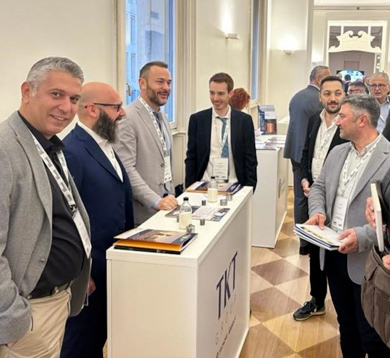Wire & Cable
Enhancing thermal stability of dry lubricants in drawing processes with sustainable additives
The Wire and Cable Milan conference on October 16, 2023, featured a groundbreaking speech by Dr. Thomas Morge and Eng. Giovanni Garoli of Koner Srl, part of TKT Group. The presentation by the title of “Sustainable additives to increase thermal stability of dry lubricants and best practice of use”, provided an extensive analysis of these elements, with practical applications on very bright wire.
This article aims to provide a concise overview, encouraging readers to explore the attached PDF[1] for a comprehensive understanding of the topic.
Understanding wire drawing theory
In wire drawing and other cold-forming processes in general, the contact zone between the wire surface and the die is subject to extremely high friction and wear. Temperatures can reach peaks of 250° to 500°C, embrittling the steel microstructure. To prevent material damage and breakage, it is therefore paramount to employ lubricants with high thermal resistance. The presentation highlighted two key lubrication mechanisms: hydrodynamic lubrication, involving a thick layer ensuring total separation between wire and die, and boundary lubrication, characterized by a thin layer between the two surfaces.
Sodium soaps as sustainable additives
The presentation introduced a study on the thermal resistance of sodium soaps, specifically sodium stearate (stearin) and sodium palmitate. These additives were combined with flame retardants and other substances to enhance their thermal stability.
Differential Scanning Calorimetry (DSC)
DSC was employed to measure the variation of heat absorbed by the material during state changes, including phase transitions, melting points, and oxidation. The study used an inert nitrogen atmosphere for a cleaner analysis and an oxidative atmosphere to replicate real conditions, (which took into account the reactive environment and the oxidative reactions involved).
Thermogravimetric Analysis (TGA)
TGA was utilized to evaluate thermal stability. The onset temperature, identified according to ASTM E2550, marked the initiation of the transition. The maximum weight loss rate and the weight loss at a fixed temperature were the two crucial parameters examined. It was observed that oxidative reactions led to an increase in weight.
How lubricants and dies influences the drawing process
The presentation concluded by emphasizing the profound impact of lubricants and dies on wire production. Understanding the thermal stability of additives through DSC and TGA provides essential insights into optimizing the wire drawing process.
In the last part, the presentation illustrated several animated simulations to show that the perfect geometry of a die, whether new or re-grinded one, significantly influences the drawing process and its results.
In order to obtain an excellent steel wire quality it’s strictly necessary to use a die with a perfect internal geometry, and the grinding and polishing operations should be carried out in a workmanlike manner.
Tecnovo has been producing lubricants and auxiliary chemicals for wire drawing and processing since 1945. Koner holds a leading position in the wire drawing die sector. Together, the companies exemplify the comprehensive expertise within the TKT Group, offering integrated solutions that span the entire spectrum of wire manufacturing processes.

